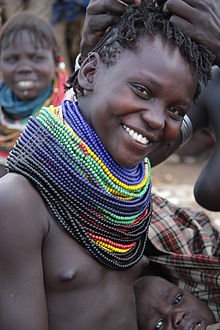
Summary
The Nyangatom also known as Donyiro and pejoratively as Bumé are Nilotic agro-pastoralists inhabiting the border of southwestern Ethiopia, southeastern South Sudan, and the Ilemi Triangle. [2] They speak the Nyangatom language.
Donyiro | |
|---|---|
 Nyangatom woman | |
| Total population | |
| 30,000[1] (est.) | |
| Regions with significant populations | |
| Languages | |
| Nyangatom language | |
| Religion | |
| Christian and Traditional African Religion | |
| Related ethnic groups | |
| Other Ateker people, Other Nilotic peoples |
Overview edit
The Nyangatom are members of the Ateker or Karamojong cluster that also contains the Turkana, Toposa, Karamojong, and Jie who speak closely related languages. They number approximately 30,000 [1] with populations in both South Sudan and Ethiopia. Many Nyangatom are nomadic, residing in mobile livestock villages that may migrate several times a year. A substantial number of Nyangatom also reside in semi-permanent villages. It is common for individuals to move between mobile cattle camps and semi-permanent villages.[2]
The Nyangatom have intermittent conflict with many of their neighbors, especially the Turkana, Dassanetch, and Suri.[3] Despite the risk of intergroup conflict, many Nyangatom have bond friends with members of other groups and there are trade relationships between the Nyangatom and many of their neighbors.
Along with other groups in the Lower Omo Valley, the Nyangatom face challenges to their future subsistence and cultural traditions due to large-scale agricultural projects occurring in their territory.[4][5]
External links edit
- BBC program Tribe, July 2006
- Website for Nyangatom Anthropology
- Nyangatom in danger of denial of access or displacement
References edit
- ^ a b Population and Housing Census Report-Country - 2007 (PDF) (Report). Central Statistical Agency. July 2010. p. 73. Retrieved 2016-08-28.
- ^ a b Tornay, Serge (1981). "The Nyangatom: An Outline of Their Ecology and Social Organization" (PDF). In Bender, M. Lionel (ed.). Peoples and cultures of the Ethio-Sudan borderlands. East Lansing: African Studies Center, Michigan State University. pp. 137–178. OCLC 8772514. Retrieved 2016-08-28.
- ^ Glowacki, Luke; Gönc, Katja (2013). Investigating the Potential of Peace Committees in Ethiopia: A Needs Assessment in IGAD CEWARN's Karamoja and Somali Clusters (PDF). IAG InterAfrica Group. OCLC 870747365.
- ^ Horne, Felix; Bader, Laetitia; Human Rights Watch (2012-06-01). "What will happen if hunger comes?": abuses against the indigenous peoples of Ethiopia's Lower Omo Valley. New York: Human Rights Watch. ISBN 9781564329028. OCLC 803626105.
- ^ International, Survival. "Omo Valley Tribes: Gibe III dam". www.survivalinternational.org. Retrieved 2016-08-28.


